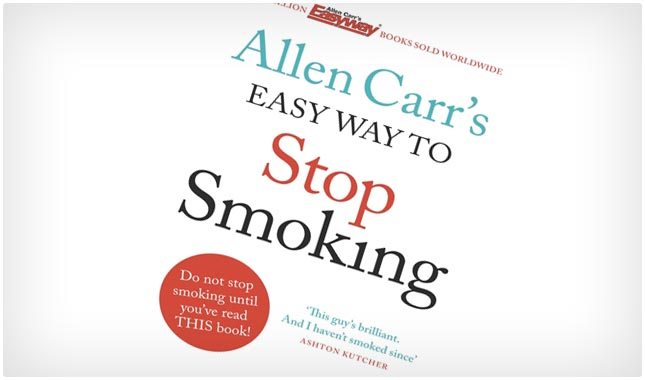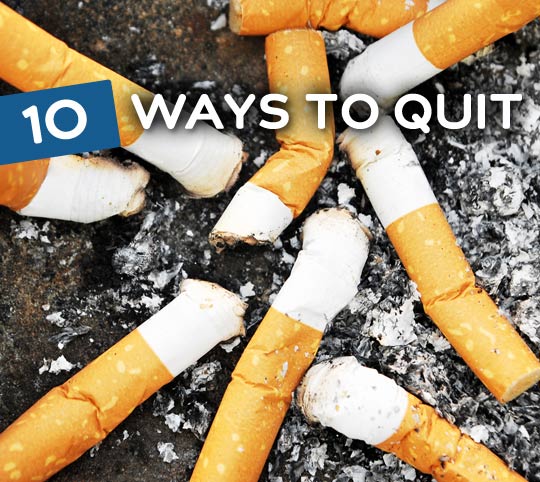Like most of the good things in life, it’s going to take some effort and perseverance if you want to someday consider yourself a non-smoker. If it were easy to quit, everyone would do it and smoking cessation wouldn’t be a multi-billion dollar industry. What it really boils down to is a matter of self-efficacy. Do you believe you can quit? The answer to that question will go a long way in deciding if any of these methods will work for you.

Go Cold Turkey: It’s Still Your Best Shot
Even with all of the self-improvement books, classes, hypnotherapists, patches, pills, e-cigarettes, and everything else designed to help with the quitting process, the most successful way – percentage-wise – is just flat out stopping.
Most people don’t consider going cold turkey because they think that it’s too hard and would never work for them. They consider of all of the inevitable cravings, the possibly weight gain, and the incessant thinking of cigarettes, and then they don’t even try it. Or they give it a half-hearted attempt, it doesn’t work out, and then their belief is confirmed that it’s not for them.
But there is one huge benefit to going cold turkey that make it a better option than all the rest: It’s free! Unlike all of the products and services you can pay forto try to quit, it doesn’t cost you a thing to simply quit. It’s also something that you can start immediately after making the decision to do so.
The trick is that you can’t go cold turkey, have it not work out for you, and then give up on the method entirely. It might take a few attempts or even many attempts before you’re able to quit for good using the cold turkey method. Here are some tips to help you get started:
1. Pick a date: start by picking a date a few weeks in advance when you plan to quit and put it on your calendar. Make sure you have nothing stressful going on during that week. For example, avoid a week where you have a large project at work or school due.
2. Write down why you’re quittin: it could be due to health issues, personal issues, or because you were told to do so by your doctor. Either way, write down all the reasons why smoking is bad for you and why quitting is necessary. You can refer back to this list whenever you feel the temptation to light up.
3. Anticipate cravings: it helps to realize that you will experience cravings by quitting cold turkey and that’s OK. You have to come up with a fast way to work around them, though. Keep in mind that most cravings only last five to ten minutes. So you could chew a piece of gum, call a friend, or play a game on your phone for ten minutes until the craving goes away.
4. Know yourself: if you normally have a cigarette after meals, then plan for an activity that will take your mind off of smoking immediately after you eat. If you smoke when you’re stressed, then you’ll need another healthy way to cope with stress. Try counting to ten, meditating, or practicing yoga. It sounds silly, but knowing yourself and when you’re most likely to crave a cigarette is the best way to work around the habit.
5. Understand the symptoms of withdrawl: nicotine is a powerful drug and you may experience withdrawl symptoms when you quit. Being aware of symptoms is a good way to fight them because you’ll know what’s coming. Irritability, depression, trouble sleeping, and headaches are all common side effects of quitting cold turkey. You can work around these by drinking lots of water, establishing a healthy bedtime routine, and consider taking a natural herbal remedy for anxiety and depression, such as turmeric.
6. Write about it: sometimes writing down how you feel is a great way to cope with difficult times. You can also join a support group to keep you on track or get your family and friends involved. The more ways you find to support yourself, the more successful you’ll be. We’ll cover these ideas more in depth later.
[list type=”arrow”]
[li]Terrie’s Story: This alone should give you enough motivation to quit. WARNING: Some viewers may be disturbed by the content and images in this video. [/li]
[/list]
[hr]

Read Allen Carr’s Easyway to Stop Smoking
This has been touted as the number one book for trying to stop smoking. Celebrities swear by it, and it’s got an impressive number of glowing reviews on its effectiveness. Here’s a fun fact: you get to smoke while you’re reading it. By the end of the book, you put out your last cigarette and that’s it! You’re supposed to be smoke-free from then on.
The book is all about putting a wedge between your old way of thinking, and your new way of thinking. Your old way of thinking got you to where you are now as a smokerIf you want to make the leap to being a non-smoker, then you need a different perspective on smoking, and this book appears to provide that.
The mental side of smoking cessation can’t be overstated, and since the answer to the problems likely can’t be given to you from your family and friends, it’s necessary to bring in a professional. A book is a way to provide the same caliber of advice, without the price tag and at times that are convenient to you.
[list type=”arrow”]
[li]Easyway to Stop Smoking by Allen Carr[/li]
[/list]

Patches, Pills, Kits, Apps, Homeopathy and More!
There are a ton of anti-smoking products and packages that you can try, and some of them have proven to be more effective than others. Here’s how to tell if a particular product is something that will help you: If you believe it will help, then it probably will. Even if it just gives you a feeling of confidence of being in control of your cravings, than it’s worth trying.
“Throw it against the wall and see what sticks!” While this method may not work for some things, it’s all about finding what works best for you. You might discover that a combination of two or three methods is the key. Or you might stumble upon one technique that gets you through the toughest times.
You might even run the gamut on every technique under the sun, find that nothing works for you, and then get a stronger resolve to quit cold turkey, satisfied that there isn’t some magic formula out there that you’re missing out on.
[list type=”arrow”]
[li]Nicoderme CQ Patches[/li]
[li]Nicorette Lozenge[/li]
[li]LifeSign QuitKey Smoking Cessation Computer[/li]
[li]Blu Cigs Electronic Cigarettes[/li]
[li]LIVESTRONG MyQuit Coach[/li]
[/list]

Hypnosis: Works for Some, Not for Others
You might have heard a lot of talk about hypnosis for smoking cessation. The idea is that you’d go in, have someone put you into a hypnotic state, and come out a non-smoker. But in reality it’s not a one-shot deal, you’ll have to reinforce the suggestions made during your session to get the full benefit.
But the method has been proven to be successful in at least a certain percentage of people that are able to be placed into that state of consciousness where suggestions can be implanted. The hypnotist will make negative associations to smoking so that when you think to smoke you immediately link it to a bad taste in your mouth, or a toxic substance that is jeopardizing your life.
It’s interesting to note that even though most smokers know that it’s bad for their health, because the harmful effects are not realized immediately and take years to develop it’s not a strong enough deterrent to stop smoking in the present. Because hypnosis creates a strong negative association and uses solid reasoning, it may be one method to consider if you’re struggling.
[list type=”arrow”]
[li]Hypnosis to Quit Smoking: Benefits and Risks[/li]
[/list]

Try to Avoid Tempting Situations
If you know the places and faces that trigger your urge to smoke, then it’s a good idea to avoid them until you have a stronger handle on your anti-smoking efforts. During the early days of trying to quit, you might not be in a place where you feel that you have a lot of control over yourself. It’s best not to tempt fate by putting yourself in a tempting situation.
If you smoke when you’re stressed, try different relaxing techniques to keep your emotions in check. If you smoke when you drink, stop drinking for awhile until you can separate the two. Every habit has a trigger, and most of them are mental, but sometimes it can be your environment that is the cause. Maintaining an environment that is conducive to your efforts is key.
You don’t have to become a hermit, but learn how to get through certain situations one at a time, so you’re not bombarded with more than you can handle during the early phases of quitting.
[hr]

Start Up Good Habits to Replace This Bad One
Smoking is often considered the granddaddy of all bad habits, so it’s a good idea to replace it with a series of good habits to show yourself a different way to live. Not having something to do with your hands is often cited as a big distraction, so you may want to start a hobby that has you working with your hands. Start a garden, knit, or get into woodworking. It’s a matter of keeping the mind occupied so you’re not sitting around wishing you were smoking.
Most people complain about weight gain when they give up cigarettes, and while it may be too much to ask to start a diet and exercise regimen while trying to stop smoking, you can start with smaller actions that can yield healthy benefits. When you want to smoke drink a glass of water, or take a short walk outside in the sunshine. Eventually you’ll develop a positive association with smoking and it won’t be such a bad thing if you think of having a smoke.
[hr]

Develop a Strong Support System
Because this is a positive change for you, it should be natural that your family and friends would support your decision and encourage you to stick with it. You may find that even if they are supportive you need to talk things over with others that are going through the journey with you. You can either meet up with local support groups or find an online forum to address your personal concerns.
So while it may feel like you’re going it alone, your actions have an effect on others, and you might be surprised to find that you’re not the only one with a vested interest in your success. If you’re feeling like no one really cares if you stop smoking or not, you might be surprised where you find that added reason to quit and be healthier.
[hr]

Do Your Best to Make This Fun 🙂
Most people focus on the pain and suffering that they imagine they’ll experience by not having the smoke breaks, but this makes it even harder to find success in quitting. Try developing a reward system that pays you out for good behavior.
In his book The Now Habit, Neil Fiore says that it’s easier to let something you want to do pull you towards it rather than to keep pushing yourself to do something you don’t want to do. Promise yourself a date night with your significant other if you can go a week without smoking. You can pay for the night with the savings of not buying all those cigarettes.
Keep in mind that you’re trying to quit so you can lead a happier, healthier, and more active lifestyle. Start incorporating those things into your life right from the start rather than thinking that they can only come once you’ve officially kicked the habit. This doesn’t have to be a process full of drudgery and pain if you can keep yourself positive with other activities.
[hr]

Don’t Get Overwhelmed By What Lies Ahead
In the same book, Fiore talks about not getting overwhelmed by a big task that lies before you. In order to overcome these feelings, he recommends that you take the entire process into view, and realize that there will be hundreds of little steps that you’ll have to take, not one big giant one.
There will no doubt be situations that test your resolve: relapses, friends that smoke that try to keep you a smoker, and all sorts of trials and tribulations. But you’ll be able to face them all one at a time as they occur, so there’s no reason to panic and think that you can’t handle this in the moment.
[hr]

Get Through the First 30 Days
There are two battles you’re waging here: one is the physical addiction to the nicotine in your body, and the other is the image of yourself as a smoker. If you can make it through the first 30 days, your body should have expelled the nicotine from your system, and you’ve then got to deal with the mental aspect of smoking. You can also take steps to help flush out the nicotine to speed along the process to stop fighting these physical symptoms.
So while you’ll be fighting with the feelings of withdrawal that come with no more nicotine intake during that first month, you’ll then be faced with not going through the motions of smoking. The feel of the cigarette between your fingers, between your lips, the ritual of taking one out of the pack and lighting up. It may sound odd, but this becomes part of your identity, of who you think you are. These urges can be even stronger than the physical withdrawal.
That’s why the first 30 days is typically the hardest, because you’ve got to deal with both the physical and the mental at the same time. But knowing that the physical will eventually get better, and you’ll be able to focus your energies on just the mental aspects, is enough for many people to make it over this first hurdle.
=
[hr]
Never Stop Quitting
Just like life, quitting smoking is a process. Rather than viewing it as having a set starting point and ending point, it’s better to view it as a part of your life that is making a change. You start stopping one day, and then each day that follows you continue to stop. Youmight never truly reach a finish line because you might have to fight the urge anew each day. As long as you keep getting trying to quit when you have a setback, you can consider yourself a success.




